- Use toothbrushes in play, so that this tool is no longer intimidating. You could use a toothbrush like a paintbrush, to brush a favourite stuffed animal’s teeth, or to brush wind up “chatting teeth”.
- Try different toothbrushes. There are many options to try including a finger toothbrush, vibrating toothbrush, light up brushes, cartoon character brushes, firm or soft bristles, and a toothbrush with a short vs. long handle or easy grip versions.
- Consider toothpaste. Some children do not like the task of brushing teeth simply because of the taste/texture of the toothpaste. There are a variety of flavours of toothpaste to try. If toothpaste is the trigger to unsuccessful toothbrushing time, then start with water only and slowly introduce toothpaste with a dot the size of a grain of rice.
- Consider positioning. Look at the best positioning for your child to complete the task of brushing their teeth since standing on a step at a sink requires balance and core strength. A supported sitting position may allow your child greater independence with this task.
- Use a timer or sing the song “This is how we brush our teeth…” for a specified number of times. For example, start with singing the song 3 times, but each week gradually increase the number of times the song is sung.
- Practice every day.
Self-care for young autistic children

It’s important to develop self-care skills early in life as it promotes a child’s confidence, self-esteem, and motor development.
Developing these skills gives children the confidence to build independence in other areas. It’s important, however small a part your chid starts to play in self-care tasks, to enable this so it can be built upon.
Key points to remember
You are not alone!
It is very common for autistic children to experience various difficulties learning or engaging in self-care tasks. Washing hair, brushing teeth and getting dressed can all trigger distress in your child, or avoidance of these tasks due to the complex skills that are needed to complete them.
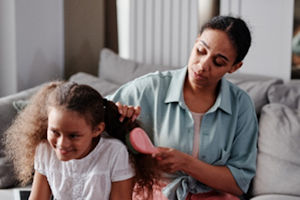
You are the expert
Perhaps the water from the shower is too powerful on your child’s skin, or maybe they want to stay in the water? Do they struggle with the transition from winter to summer clothes? Do they become distressed with brushing teeth/hair or struggle with doing their buttons? Perhaps they like things to be done in a particular order…? Do they struggle to grip the toothbrush, or fall over putting on trousers?
 Every child is unique and it requires being a detective, combining your knowledge of your individual child with knowledge of autism to find out why certain activities are difficult and therefore how best to support your child.
Every child is unique and it requires being a detective, combining your knowledge of your individual child with knowledge of autism to find out why certain activities are difficult and therefore how best to support your child.Make it fun!
Use your knowledge of your child to inform what you try. What do they like to do? Are there particular games they enjoy which keep them engaged, or a particular time of day they are more focused? Making self-care fun will help to keep them engaged.
Repetition and perseverance are keyUse your knowledge of your child to inform what you try. What do they like to do? Are there particular games they enjoy which keep them engaged, or a particular time of day they are more focused? Making self-care fun will help to keep them engaged.
Learning new skills takes time. Progress may be slow so be sure to look out for and celebrate small steps towards your goals.
Before you Start
We have created this video which explains more about how to support your child in developing their self-care skills.
You can click here to read a written transcript of this video.

Having watched the video above, think of a self-care goal which will be most useful for your child right now. It is important to be realistic with these and break down goals into simple steps. This will help both you and your child to stay motivated.
Next, think about the environment where the task takes place?
Next, think about the environment where the task takes place?
- Is it noisy?
- Consider the temperature
- Are there any smells your child may find difficult?
- Can they access the equipment they need, for example, can they reach their clothes easily? Do they like to have these laid out so they know what will happen next?
Top Tips
With a goal in mind, you can start to trial different approaches and strategies depending on the difficulties your child has. A few top tips which are often helpful are:
- Try to structure activities so they become predictable, for example, doing things at the same time each day, and using the same preferred products.

- Use simple visuals, or a social story to help your child understand what to expect and what will happen next. This can give them a sense of control over the situation which can ease levels of distress. You can find more information about using visuals on our “Supporting Understanding” advice page or you can download example social stories for bath time and hair washing here . This website offer some useful visuals for daily living skills and self-care which may be useful.
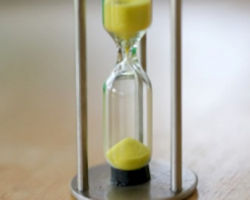
- Use a visual timer, such as a sand timer, or countdowns (e.g. “5,4,3,2,1..shampoo finished”) to help your child understand how long something will go on for and when it will finish. Make sure to honour the countdown (so no extensions…!)
- Try using deep pressure (e.g. firm hugs) before and/or after self-care tasks. This can help some children to regulate if they have sensory needs. For example, it may help them cope with the sensation of water or clothes on their skin. Please refer to our “Sensory Needs” advice page and video for more advice on this. Generally, firm touch is easer for the body to tolerate than lots of light “tickly” touch, so bare this in mind with the activity itself as well.
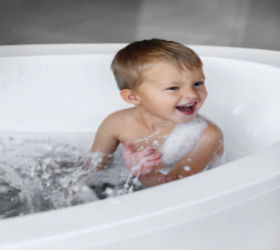
- Involve your child in the task where possible, such as by getting them to rub in their own shampoo or pour a jug of water over their head in the bath. This can give them a feeling of control and predictability over situation.
- Offer choices where possible, such as a choice of two t-shirts to wear or which squeezy toy to hold while you wash their hair.
- Consider ways to make the task easier for your child, such as by changing their positioning for toothbrushing or the types of clothes you are dressing them in (you will find more examples below).
- Allow extra time for more demanding sensory activities, for example allowing more time to get dressed in the morning so it is not a rush.
- If they struggle with their grip, such as when holding buttons, or brushes for self-care, help them develop their fine motor skills using the information on this page .
Teaching new skills

- You can help your child understand how to do a task using hand over hand support. This enables them to feel the movement as you do it with them, and therefore learn it. You might use this to support them to learn to brush their teeth or hair for example. This takes repetition!
- Break tasks down into achievable steps. Backward chaining (more information on this here ) can be useful with dressing. The adult begins the task with the child only completing the last step. Once your child can do the last step, teach the second to last step, etc. Gradually the adult does less and less until the child is able to do more of the task themselves. Praise your child for completing the last stage and say, “You did it!”
Tips for specific tasks
Brushing teeth
Bath time and washing hair
- Offer your child goggles to wear in the shower when hair washing.
- Use dry shampoo some of the time.
- Use squeezy toys in bath.
Brushing hair
- Practice hair brushing or “doing each other’s hair” at other times or pretend to brush toy animal’s hair.
- Whenever possible massage the scalp prior to hair brushing as this can help to reduce sensitivity.
- Use a tangle free conditioner when washing the hair.
- Keep oil/conditioner handy for hair (depending on hair type) to ease sensation on scalp if sensitive.
- Try to use a soft brush that won’t yank on the hair.
- If the hair is long, then hold it at the shank to avoid pulling on the scalp.
- Consider positioning. Depending on your child’s age and preference, try having them sit on an adult’s lap, or on a comfortable chair or beanbag, to help them feel more secure while having their hair brushed.
- Offer squeezy toys to hold when having hair done.
- If children can see themselves in a mirror while their hair is brushed it can give them a greater sense of control and they may tolerate the brushing better.
- Try not to prolong the activity and maybe avoid looking for perfection. Stop the activity if the child is getting really distressed.
Hair cuts
- Try substituting scissors for clippers when having hair cut or vice versa.
Cutting nails
- Try cutting one finger nail a day rather than all 10 in one go.
- Try a nail file instead of clippers or scissors.
Dressing
- Be sure to use clothes that are easy and comfortable for your child to move in and which they find most comfortable to wear once on. Think about whether they prefer looser or tighter fitting clothing. Offer choices with clothing where possible.
- Consider looking for sensory friendly clothing or help them by cutting labels out of their clothes. They may prefer seamless socks or particular fabrics. Click here or here for sources of sensory friendly clothing you may find useful.
- If your child finds summer clothes difficult, you can swap the sensory input of winter clothes for a small rucksack with small water bottle to aid transition to summer clothing. This, helping your child feel where their body is in space.
- To practice dressing, where possible use stretchy, loose-fitting clothes which are easier to get on and off like elastic waisted trousers, clothes with Velcro or large buttons and buttonholes.
- Consider positioning for dressing, such as whether they might find it easier sitting down.
- Use jumpers, t-shirts and underwear with pictures on the front to help your child work out front from back.
- Lay your child’s clothes out on the bed or floor in the way they are going to put the item on.
- Break down the task into achievable steps and use simple language to help your child along the way.
- Use hand-over-hand modelling to help your child achieve the last step, and then remove your hands when they feel more confident.
- Teach your child to ‘dive’ into their t-shirts/jumpers by placing it in front of them on the table top, with the front face down, and with the neck and arms the furthest away, like in the picture below. Your child then ‘dives’ into it, putting their arms in first.
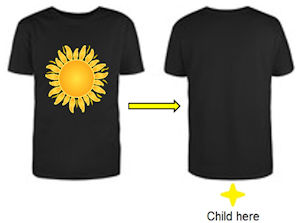
- To teach your child to put their coat on, place the coat open, with the collar nearest to them and the lining uppermost. Your child slides their arms into the sleeves and swings the coat over their head. You can see a video example of this here .
- To teach your child to put their trousers on, lay the trousers on the floor, face up and position your child at the top, for easy access, as in the picture below.
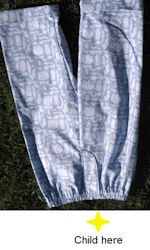
- Draw a smiley face in the inside of your child’s shoes or use left and right stickers to help them line the shoes up before they put them on, as in the image below.
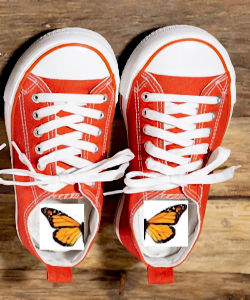
What Next?
Come to a Next Steps Session. If your child is currently being supported by the social communication team, then, once you have watched the video above and tried some strategies, please sign up for a Occupational Therapy Next steps session to discuss your questions and queries with members of our team, along with other families facing similar challenges. You can find dates and details of how to book here .Last updated10 Sep 2025


